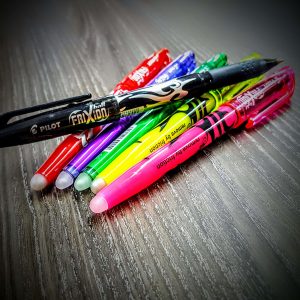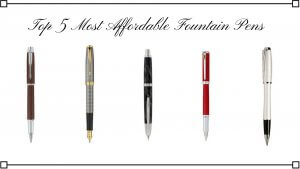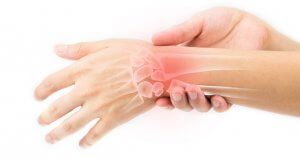The Many Types of Pen
1st November 2017 | Posted in Ballpoint Pen, Fountain Pens, Fun Facts, Review

There have been many different types of marking instruments over the years from chisels, chalk and lead to brushes, quills and fountain pens and due to modern advances in pen manufacturing.
Ball point

A ball point pen has a simple but effective design; it includes a precisely formed metal ball which has a continuous flow of ink from the reservoir. The first great success for the ballpoint pen was in October 1945 being sold in New York’s Gimbels Department Store however it didn’t reach any commercial significance until the 1950’s.
Rollerball

A rollerball pen has similar features to both ball point pens and fountain pens. This is due to the fact that it uses a ball tip which is what ballpoint pens use. Also, rollerball pens use a liquid based ink which is the same as in a fountain pen. Rollerball pens were introduced in 1963 in Japan.
Gel pen

Gel pens use the same basic mechanism as a ball point pen; however they differ with the type of ink that they use. Gel pens have a much more viscous (thick) ink and often come in a much wider range of colours, offering ink with added aluminium sparkles for added visual effect.
Fountain pen

Fountain pens were created by Lewis Waterman so that he could avoid having to dip quill pens into an ink bottle, allowing him to have a continuous flow of writing. He patented the first practical fountain pen in 1884. The reason it is called a fountain pen is because it has a reservoir or cartridge from which ink flows continuously to the nib.
Fine liner (fibre tip)

Fine liner pens are predominantly used for graphics, sketching or drawing however, many people select these pens for handwriting as the metal-clad tip allows a unique writing experience. The majority of fine liner pens use a dye based ink however; there are also fine liners available which use lightfast and waterproof pigment ink. These inks are favoured for technical drawing due to the dye based ink not being completely permanent.
Technical

Technical pens are specialised to give a line of constant width for precision. They are mostly used by architects, drafters and engineers. In the modern day, many people favour using CAD software instead of producing technical drawings by hand. However, people have adopted these pens for handwriting and other types of drawing since the creation of them.
Calligraphy

Calligraphy is originally a style of writing, known to be a fairly artistic form of handwriting. This style of writing is what encouraged “calligraphy pens” to be designed. Calligraphy pens have specialised nibs and can come in the form of a standard pen with an ink reservoir or also as a dip pen which is dipped into a pot of ink to write.
Mechanical pencil

A mechanical pencil uses lead as a form of writing/ drawing but unlike your standard pencil the lead can be mechanically extended instead of having to sharpen it and also the lead can be replaced when it has worn away. Some advantages of using mechanical pencils are they don’t need to be sharpened so they save time; the lines are consistent; they have a balancing technology to help you write comfortably.
Technical drawing pen

Technical drawing pens are mainly used for architectural/ engineering drawings as they make lines of a constant width which helps make the drawing as precise as possible. These pens can also be used for writing; some people prefer them because they don’t smudge easily which helps produce a neat piece of writing.
View Our Technical Drawing Pens
Multifunction

Multi-function pens give you the option to easily switch between writing and drawing techniques. For example, in a 3 function pen you could have one ball point pen nib, one stylus pen nib and then one pencil nib to select from. There are a number of different ways in ways in which you can select which pen function you want to use. Such as twisting the pen or a sliding mechanism.
Dry wipe

Dry wipe pens are specifically for use on dry-wipe surfaces. They come in a range of different colours which can easily be wiped off dry-wipe surfaces with no permanent marks. Dry wipe surfaces include whiteboards, glass and coloured dry-wipe surfaces.










Leave a Reply